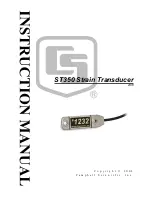
69
Appendix D Glossary & Abbreviations
Ammonia (NH3)
—A colorless gaseous alkaline compound which is soluble in water. It
has a characteristic pungent odor, and is used as a fertilizer. In water and soil, ammonia is
present primarily as NH
4
+
ions and is readily assimilated by plants during nutrition.
Ammonium (NH
4+
)
—Ammonium is a form of ammonia by the addition of a hydrogen ion
(H
+
) to an ammonia molecule (NH
3
). Ammonia is converted to ammonium as the pH of a
solution drops. Ammonium is less harmful to aquatic life than ammonia. Below a pH of 7.3,
more than 99% of the total ammonia is present as ammonium.
Assembly
—A unit containing the component parts of a mechanism, machine, or similar
device. Probe Assembly: The unit containing the component parts of a sensor (e.g.
D.O.:component consisting of the D.O. sensor which is made up of 2 electrodes the
cathode and the anode).
Chloride (Cl–)
—A common anion, present in both fresh and sea water. It is essentially
non-toxic, and is present in all living cells.
Conductivity
—Conductivity is inversely related to the resistance of a solution.
Conductivity is the ratio of the electric current density to the electric field in a material, also
known as electrical conductivity. In limnology, conductivity is a measure of the ability of
water to pass an electrical current. Compensation of this measurement to 25 °C
constitutes specific conductance. This parameter indicates the amount of dissolved
substances (salts). Salts and their concentration dictate osmoregulatory (salt-balancing)
functions in plants and animals. The ionic strength of water also regulates the toxicity of
many substances. (See: Specific conductance)
Data collection platform (or DCP)
—Hardware system and system software used with a
computer program to collect data at one or more locations.
Depth
—The vertical distance between the water surface and another level (for a
multiprobe: 0–10, 0–25, 0–100, or 0–200 meters). (See: Vented depth)
Derating
—The reduction of the rating of a device to improve reliability or to predict
operation at higher or lower ambient temperatures.
Dissolved oxygen (or D.O.)
—A measure of the amount of oxygen present in water and
available for respiration. The concentration of D.O. is controlled by many factors including:
consumption by aerobic (requiring D.O.) organisms (bacteria, fish, amphibians, and
invertebrates); consumption by plants (algae, vascular plants, particularly during dark
hours); and water temperature, water flow, and depth
Drift
— The long-term lack of repeatability caused by fouling of the sensor, shifts in the
calibration of the system, or slowly failing sensors.
Dump
—To copy the contents of all or part of a storage, usually from an internal storage
device to an external storage device.
Eh
—(See: Redox potential)
Electrode
—An electric conductor which either measures the potential of a solution (pH,
reference, redox, and ammonium electrodes) or forces electric current into or out of a
solution (D.O. and conductivity electrodes).
Emery cloth
—An abrasive cloth or paper with an adherent layer of emery powder; used
to polish and clean metal. (No. 400 or finer is recommended.)
Summary of Contents for Hydrolab DS5
Page 2: ......
Page 8: ......
Page 14: ......
Page 17: ...17 Installation Figure 5 Assembly Options...
Page 18: ......
Page 34: ...34 Deployment Figure 12 Open Water Deployment...
Page 52: ......
Page 68: ......






































